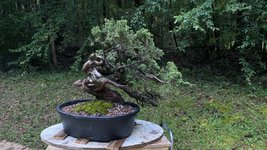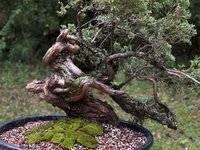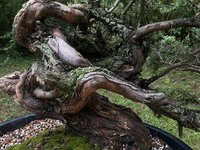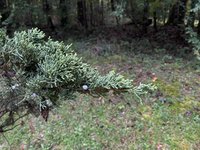FoldedFrog
Mame
Collected a rather nice urban yamadori yesterday (ethically and with permission). For scale this is in a 24" pot. This guy was in some nice, light soil which terminated at a layer of Georgia red clay about 12" deep (this helped keep the roots fairly shallow). There were two larger lateral roots that had to be cut but it still has plenty of fine feeder roots at the base of the tree. Before I collected, I ventured into the woods and raked back the pine top layer down to the micorrhiza-laden layer of humus and obtained about half a bucket which I chopped up and screened as an inoculant. I mixed this with some organic conifer bonsai soil mix and prepared the pot. The rootbal was so light that despite my (and my cohort's) best efforts, it fell apart as we gently tipped it to get a tarp underneath. Still, you are as careful as you can be given each situation. I don't do much collecting and my results have, of course, been mixed in the past. Since this is a conifer, I kept as much of the root ball soil intact as possible and placed this as gingerly in the pot as (we) could, filling the bottom and sides with my soil mix. Aftercare is where I would like the most feedback. So far, here are my plans:
Keep the foliage misted several times a day
Make sure the soil stays at least damp but not saturated (I've always wondered how to balance this between the original soil in the pot and the granular bonsai soil around the periphery)
No direct sunlight but no overhead shade for a while. I prefer that the tree looks up at clear blue sky while in recovery then moved to a spot of morning sun later.
I also believe in a light application or good organic fertilizer during recovery. I know that others don't, but I don't want to deny vitamins to a sick patient.
Question: Insecticide/Fungicide at this time, yes or no?
Any other tricks of the trade you guys may have found particularly successful?
I welcome all opinions but arguments typically don't help me!




Keep the foliage misted several times a day
Make sure the soil stays at least damp but not saturated (I've always wondered how to balance this between the original soil in the pot and the granular bonsai soil around the periphery)
No direct sunlight but no overhead shade for a while. I prefer that the tree looks up at clear blue sky while in recovery then moved to a spot of morning sun later.
I also believe in a light application or good organic fertilizer during recovery. I know that others don't, but I don't want to deny vitamins to a sick patient.
Question: Insecticide/Fungicide at this time, yes or no?
Any other tricks of the trade you guys may have found particularly successful?
I welcome all opinions but arguments typically don't help me!




Last edited:
